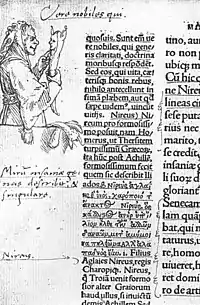In Praise of Folly
In Praise of Folly, also translated as The Praise of Folly (Latin: Stultitiae Laus or Moriae Encomium), is an essay written in Latin in 1509 by Desiderius Erasmus of Rotterdam and first printed in June 1511. Inspired by previous works of the Italian humanist Faustino Perisauli De Triumpho Stultitiae, it is a satirical attack on superstitions, various traditions of European society, and on the Latin Church.[1]
_(14782268725).jpg.webp) Cover of a 1728 French edition, L'Éloge de la Folie | |
| Author | Desiderius Erasmus |
|---|---|
| Original title | Moriae encomium |
| Translator | Thomas Chaloner White Kennett James Copner John Wilson Harry Carter Betty Radice |
| Country | France |
| Language | Latin |
| Genre | essay, theology |
| Publisher | Gilles de Gourmont |
Publication date | 1511, revised many times up to 1532 |
Published in English | 1549 |
| Media type | Print: hardback |
| 873.04 | |
| LC Class | PA8514 .E5 |
| Preceded by | Handbook of a Christian Knight |
| Followed by | Copia: Foundations of the Abundant Style |
Original text | Moriae encomium at Latin Wikisource |
| Translation | In Praise of Folly at Wikisource |
Erasmus revised and extended his work, which was originally written in the space of a week while sojourning with Sir Thomas More at More's house in Bucklersbury in the City of London.[2] The title Moriae Encomium had a punning second meaning as In Praise of More (in Greek moría translates into "folly").[3] In Praise of Folly is considered one of the most notable works of the Renaissance and played an important role in the beginnings of the Protestant Reformation.[4]
Content

In Praise of Folly begins with a satirical learned encomium, in which Folly praises herself, in the manner of the Greek satirist Lucian (2nd century AD), whose work Erasmus and Sir Thomas More had recently translated into Latin; it then takes a darker tone in a series of orations, as Folly praises self-deception and madness and moves to a satirical examination of pious but superstitious abuses of Catholic doctrine and corrupt practices in parts of the Roman Catholic Church—to which Erasmus was ever faithful—and the folly of pedants. Erasmus had recently returned disappointed from Rome, where he had turned down offers of advancement in the curia,[5]: xi and Folly increasingly takes on Erasmus' own chastising voice. The essay ends with a straightforward statement of Christian ideal: "No Man is wise at all Times, or is without his blind Side."
Erasmus was a good friend of More, with whom he shared a taste for dry humor and other intellectual pursuits. The title Moriae Encomium could also be read as meaning "In praise of More". The double or triple meanings go on throughout the text.
The essay is filled with classical allusions delivered in a style typical of the learned humanists of the Renaissance. Folly parades as a goddess, offspring of Plutus, the god of wealth and a nymph, Youth. She was nursed by two other nymphs, Inebriation and Ignorance. Her faithful companions include Philautia (self-love), Kolakia (flattery), Lethe (forgetfulness), Misoponia (laziness), Hedone (pleasure), Anoia (dementia), Tryphe (wantonness), and two gods, Komos (intemperance) and Nigretos Hypnos (heavy sleep). Folly praises herself endlessly, arguing that life would be dull and distasteful without her. Of earthly existence, Folly pompously states, "you'll find nothing frolic or fortunate that it owes not to me."
Reception
Moriae Encomium was hugely popular, to Erasmus' astonishment and sometimes his dismay. Even Erasmus' close friends had been initially skeptical and warned him of possible dangers to himself from thus attacking the established religion. Even Pope Leo X and Cardinal Cisneros are said to have found it amusing.[6] Before Erasmus' death it had already passed into numerous editions and had been translated into Czech, French, and German. An English edition soon followed. It influenced the teaching of rhetoric during the later sixteenth century, and the art of adoxography or praise of worthless subjects became a popular exercise in Elizabethan grammar schools.[7] A copy of the Basel edition of 1515/16 was illustrated with pen and ink drawings by Hans Holbein the Younger.[8] These are the most famous illustrations of In Praise of Folly.
Its role in the beginnings of the Protestant Reformation[4] stems from its criticism of the practices of the Church and its political allies.[9]
Erasmus subsequently wrote that he almost regretted writing it, such had been the trouble it had caused him. But this trouble did not come from the satirized princes, popes, bishops, abbots, cardinals, famous scholars, courtiers, magistrates or wives, but from certain theologians.[10]
Notes
- Zweig, Stefan (1934). Erasmus And The Right To Heresy. pp. 51–52. Retrieved November 22, 2020.
- Bucklersbury was "A short street leading from the junction of Cheapside and Poultry to Walbrook. It barely exists today." source with map.
- Müller, Christian (2006). Hans Holbein the Younger: The Basel Years, 1515-1532. Prestel. p. 146. ISBN 978-3-7913-3580-3.
- Janin, Hunt (2008). The University in Medieval Life, 1179–1499. McFarland. p. 160. ISBN 9780786452019. "Although Erasmus himself would have denied it vehemently, later reformers found that In Praise of Folly had helped prepare the way for the Protestant Reformation."
- Levy, A. H. T. (1993). "Introduction". Praise of Folly. Penguin. ISBN 0140446087.
- Collett, Stephen (1823). Relics of literature. Ludgate Hill, London: Thomas Boys.
- McDonald, Charles O. (1966). The Rhetoric of Tragedy: form in Stuart drama. Amherst: University of Massachusetts Press.
- Wolf, Norbert (2004). Hans Holbein the Younger, 1497/98–1543: the German Raphael. Cologne: Taschen. p. 11. ISBN 3822831670.
- Von Dehsen, Christian D.; Scott L. Harris, eds. (1999). Philosophers and Religious Leaders; Volume 2 of Lives and legacies. Greenwood Publishing Group. p. 62. ISBN 9781573561525.
- Erika Rummel, ed. (1990). "Letter to Dorp". The Erasmus Reader. University of Toronto Press. JSTOR 10.3138/j.ctt1287x95.12.
External links
- Praise of Folly, and Letter to Maarten Van Dorp, 1515. Translated by Betty Radice. Introduction and notes by A.H.T. Levi. Penguin, 1994.
- The Praise of Folly. Translated from the Latin, with an Essay & Commentary, by Hoyt Hopewell Hudson.With a new foreword by Anthony Grafton. Princeton Classics, 1969.
- The Praise of Folly, translated by John Wilson in 1668, at Project Gutenberg
- Praise of Folly at Internet Archive (multiple translations)
- In Praise of Folly, with portrait, life of Erasmus, and his Epistle to Sir Thomas More. Translator not stated. 1922.
- The Praise of Folly, English audiobook recording at LibriVox. The Wilson translation.
- In Praise of Folly from Christian Classics Ethereal Library. The Wilson translation.
